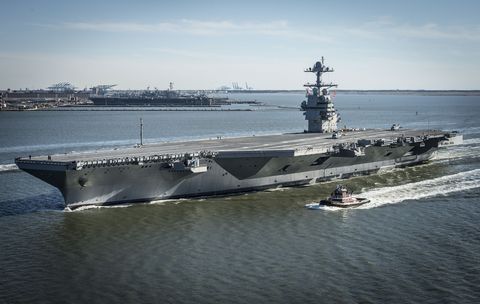The Navy’s Newest Aircraft Carrier Is Delayed, Yet Again
The USS Ford is already two years behind schedule and billions over budget.
By Kyle Mizokami U.S. NAVY/GETTY IMAGES
U.S. NAVY/GETTY IMAGESThe USS Gerald R. Ford, the first in a new class of aircraft carriers, will be delivered to the U.S. Navy three months later than planned. The Navy says the delay is necessary to resolve issues with the ship’s nuclear propulsion system and elevators designed to lift munitions up to the hangar. The technologically ambitious Ford, which introduces several technologies to frontline service, is already at least two years behind schedule.
The Navy, per USNI News, says that the Ford won’t be delivered to the fleet in July as originally planned but October. The service says that it needs the extra three months beyond the planned 12 months shakedown period to make adjustments to the nuclear propulsion system and fix the Advanced Weapon Elevators. The problem with the propulsion system isn’t related to the nuclear reactors but rather the turbines driven by the steam produced by the reactors.
The Advanced Weapon Elevators, on the other hand, are an ongoing problem. Unlike past elevators, the AWEs use electromagnetic propulsion to move munitions from the magazine to waiting aircraft. The electromagnetic powered elevators, as UPI reported earlier this month, are designed to lift 20,000 pounds of munitions at a rate of 150 feet per minute. Older elevators on the previous Nimitz-class moved 10,500 pounds of munitions at 100 feet per minute.
Technical problems saw the Ford commissioned into the U.S. Navy in July 2017 with zero of the planned eleven elevators. Ford current has two certified and working elevators.
The USS Ford, which includes other technologies such as an electromagnetic aircraft catapult, a new system for landing aircraft, and a new radar, is now more than two years behind schedule and at least 22 percent over budget. Originally forecast to cost $10.5 billion, the carrier’s construction cost is now at $13.027 billion, making it the most expensive warship ever built. Almost all of the new technology has had developmental problems and cost overruns--for example, the cost of the landing system has tripled from $301 million to $961 million dollars.
Ford is scheduled to make its first operational deployment cruise in 2021. It’s unknown if this latest delay will impact that schedule at this point. Built by Huntington Ingalls Industries in Virginia, Ford is the first of its kind. The Navy has identified two follow-on ships for now, John F. Kennedy and Enterprise, and eventually all of the service’s Nimitz-class carriers will be replaced by Ford-class ships.
No comments:
Post a Comment